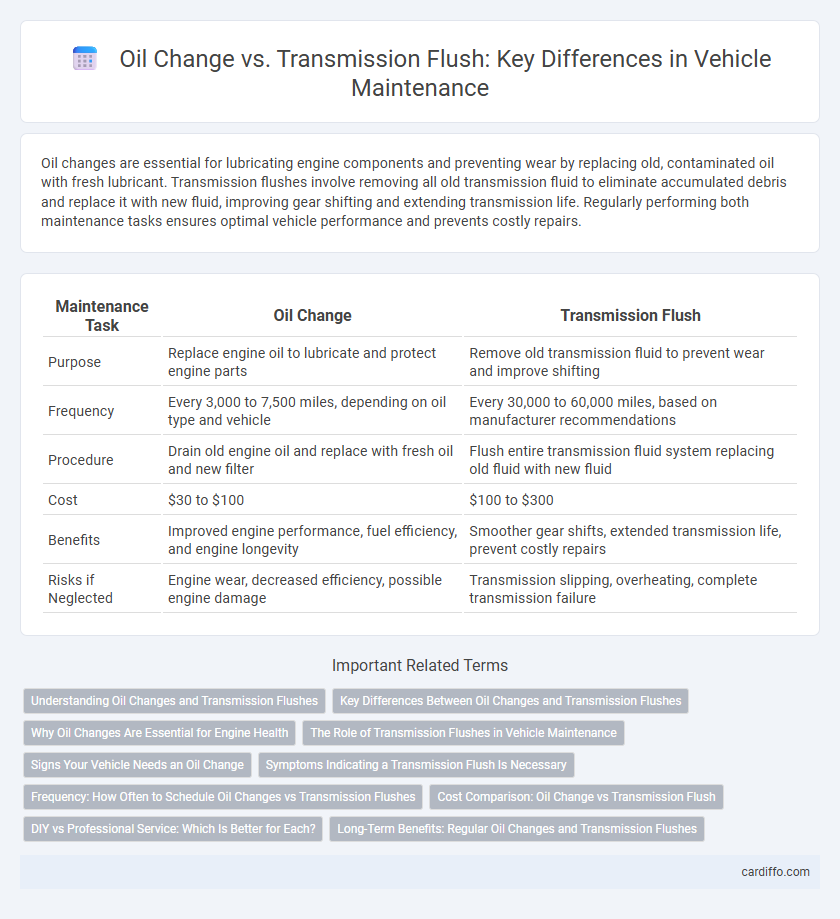Oil changes are essential for lubricating engine components and preventing wear by replacing old, contaminated oil with fresh lubricant. Transmission flushes involve removing all old transmission fluid to eliminate accumulated debris and replace it with new fluid, improving gear shifting and extending transmission life. Regularly performing both maintenance tasks ensures optimal vehicle performance and prevents costly repairs.
Table of Comparison
| Maintenance Task | Oil Change | Transmission Flush |
|---|---|---|
| Purpose | Replace engine oil to lubricate and protect engine parts | Remove old transmission fluid to prevent wear and improve shifting |
| Frequency | Every 3,000 to 7,500 miles, depending on oil type and vehicle | Every 30,000 to 60,000 miles, based on manufacturer recommendations |
| Procedure | Drain old engine oil and replace with fresh oil and new filter | Flush entire transmission fluid system replacing old fluid with new fluid |
| Cost | $30 to $100 | $100 to $300 |
| Benefits | Improved engine performance, fuel efficiency, and engine longevity | Smoother gear shifts, extended transmission life, prevent costly repairs |
| Risks if Neglected | Engine wear, decreased efficiency, possible engine damage | Transmission slipping, overheating, complete transmission failure |
Understanding Oil Changes and Transmission Flushes
Oil changes involve replacing engine oil to ensure proper lubrication and prevent engine wear, typically recommended every 3,000 to 7,500 miles depending on vehicle type and oil quality. Transmission flushes remove old transmission fluid and contaminants to maintain smooth shifting and extend transmission life, often suggested every 30,000 to 60,000 miles. Differentiating these services is critical for vehicle performance, as oil changes primarily protect the engine while transmission flushes focus on the transmission system's longevity and efficiency.
Key Differences Between Oil Changes and Transmission Flushes
Oil changes focus on replacing engine oil to lubricate and protect engine components, typically performed every 3,000 to 7,500 miles depending on the vehicle and oil type. Transmission flushes clean out old transmission fluid and contaminants from the transmission system, recommended usually every 30,000 to 60,000 miles to maintain smooth shifting and prevent transmission wear. The key difference lies in their target systems and frequency, with oil changes essential for engine health and transmission flushes critical for transmission longevity.
Why Oil Changes Are Essential for Engine Health
Regular oil changes are crucial for engine health because they remove contaminants and prevent sludge buildup that can degrade engine performance. Fresh oil lubricates moving parts, reducing friction and wear, which extends the engine's lifespan. Skipping oil changes can lead to overheating and costly engine repairs, highlighting their importance over transmission flushes for overall vehicle maintenance.
The Role of Transmission Flushes in Vehicle Maintenance
Transmission flushes play a critical role in vehicle maintenance by removing accumulated debris and old transmission fluid, which helps to prevent gear slippage and overheating. Unlike regular oil changes that maintain engine lubrication, transmission flushes ensure smooth shifting and prolong the lifespan of the transmission system. Regular transmission flushes, typically recommended every 30,000 to 60,000 miles, enhance overall vehicle performance and reduce costly repairs.
Signs Your Vehicle Needs an Oil Change
Diminished engine performance, unusual engine noises, and dark, dirty oil on the dipstick are clear signs your vehicle requires an oil change. Frequent engine overheating and increased exhaust smoke also indicate degraded oil quality affecting lubrication. Regularly checking oil levels and color helps prevent damage and maintain optimal engine efficiency.
Symptoms Indicating a Transmission Flush Is Necessary
Signs indicating a transmission flush is necessary include delayed or harsh shifting, transmission slipping, and unusual noises such as grinding or whining. Dark or burnt-smelling transmission fluid also signals contamination requiring immediate attention. Regularly monitoring these symptoms helps prevent costly transmission repairs and extends vehicle longevity.
Frequency: How Often to Schedule Oil Changes vs Transmission Flushes
Oil changes are typically recommended every 3,000 to 7,500 miles, depending on the vehicle manufacturer and oil type, to maintain engine performance and longevity. Transmission flushes are generally advised every 30,000 to 60,000 miles to ensure smooth shifting and prevent transmission wear. Scheduling oil changes more frequently than transmission flushes helps protect engine components, while less frequent transmission service prevents buildup of contaminants in the transmission system.
Cost Comparison: Oil Change vs Transmission Flush
An oil change typically costs between $30 and $75, depending on the vehicle and oil type, while a transmission flush can range from $150 to $300 due to the complexity of the service. The oil change requires replacing engine oil and filter, which is less labor-intensive compared to the transmission flush that involves draining and replacing the transmission fluid and cleaning the system. Understanding these cost differences helps vehicle owners budget maintenance expenses effectively and choose the service that aligns with their vehicle's needs.
DIY vs Professional Service: Which Is Better for Each?
Oil changes can often be performed as a DIY task, requiring basic tools and minimal time, making it accessible for most vehicle owners to maintain engine health regularly. Transmission flushes are more complex, involving specialized equipment and technical knowledge to avoid damaging the transmission system, so professional service is generally recommended to ensure proper fluid replacement and system integrity. Choosing between DIY and professional service depends on the procedure's complexity and the risk of costly errors, with oil changes suiting DIY enthusiasts while transmission flushes benefit from expert handling.
Long-Term Benefits: Regular Oil Changes and Transmission Flushes
Regular oil changes maintain engine lubrication, reducing wear and preventing overheating, which extends engine lifespan and improves fuel efficiency. Transmission flushes remove old fluid and contaminants, enhancing gear performance and preventing costly transmission repairs. Consistent maintenance of both ensures optimal vehicle reliability and long-term cost savings.
Oil Change vs Transmission Flush Infographic

 cardiffo.com
cardiffo.com